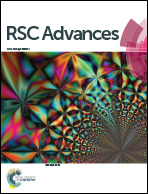Density functional theory study of hydrogenation of S to H2S on Pt–Pd alloy surfaces†
Abstract
In this work, the adsorption of S-containing species (S, HS, and H2S) and the hydrogenation of S on the Pt–Pd alloy were investigated by using the periodic density functional theory (DFT). The energy minimum of the adsorbed S, HS, and H2S were identified to bind preferentially on the fcc, bridge and top sites, respectively. Compared to single metal surfaces, the adsorption energies of adsorbates were calculated to be larger on the Pt–Pd alloy surfaces and adsorbed preferably on the sites with a majority of Pt atoms. The reaction pathways and energy profiles for the conversion of adsorbed S and H into gas phase H2S were determined. The results showed that both the S + H and HS + H reactions on Pt–Pd alloy surfaces were endothermic. The energy for the overall reaction on Pt–Pd alloy surfaces decreased significantly by 0.30–0.55 eV compared to pure Pt(111) surface. In addition, the energy barrier on Pt–1Pd(111) (one Pt atom was replaced by Pd atom on Pt(111) surface) was lower than that on other studied alloy surfaces. The above characteristics revealed that the hydrogenation of S to H2S was easier on Pt–1Pd(111) surface than on the other alloy surfaces. The partial density of states was utilized to illustrate the interaction mechanisms between S-containing species and surface atoms.


 Please wait while we load your content...
Please wait while we load your content...